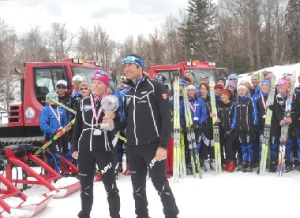For most Americans, March Madness is an activity contested indoors. In Alaska, March is the time Alaskans take the madness outside.
Take, for instance, the 1,000-mile Iditarod sled dog race from Anchorage to Nome, perhaps the hardest, coldest, most challenging ultra-endurance adventure imaginable. This year’s winner, Dallas Seavey, 25, was the youngest musher ever to win. He finished ahead of his father, 2004 Iditarod Champion, Mitch, and his 74-year-old grandfather, Dan. Alaskan madness may be hereditary.
For those who prefer to, you can join the human-powered ultra-madness and run, bike, or ski the same 1,000 miles sans dogs, by entering the Iditarod Trail Invitational, also in March.
The Alaska Pacific University (APU) Nordic Ski Center made history with its own version of outdoor Madness this March, when the Center’s Kikkan Randall won the Overall Sprint World Cup title, the first Crystal Globe in 30 years for the United States. The Crystal Globe represents the highest overall achievement, showing both good results and incredible consistency.
And she did it while skiing part of her Cup-clinching race on one ski after her binding broke.
In December 2011, Alaskans Randall and teammate Sadie Bjornsen–both of the APU Nordic Ski Center—had already made U.S. sports history when they became the first American team to medal in a World Cup Nordic cross-country relay.
In America, these notable achievements get little press coverage. However, in Scandinavian countries Nordic skiers are major celebrities and Nordic skiing is their Super Bowl. The 2011 Nordic World Ski Championships held in Oslo Norway drew 650 competitors from more than 60 nations,1,800 media representatives, 2200 volunteers, at least 300,000 spectators and several hundred million TV viewers from all over the world.
These American World Cup victories were the culmination of several years of success for the APU Nordic Ski Center, a program of Alaska Pacific University, a tiny, Ivy-League-style liberal arts and sciences campus in Anchorage whose students are crazy about outdoor sports. In 2010 three of the U.S Olympic Cross Country Ski team members were from APU: Kikkan, Holly Brooks, and James Southam.
In the summer of 2011 the U.S. women’s ski team joined the APU skiers to train on the glacier for a blend of hard training, camaraderie, and fun. The latter is a hallmark of the team’s philosophy and a reason for its success. The APU Nordic Ski Center has more people out skiing, more people racing, and–most important–more good experiences and good friendships established in the Anchorage community.
The APU Nordic Ski Center is not a NCAA or NAIA sport but rather a hybrid university-community club. The team’s community service ethos has a significant impact on the local community as APU athletes and coaches conduct youth clinics at schools and community events. They helped nearly every team at the Alaska State High School Championships, a wonderful display of top skiers and coaches passing along their passion and skills to younger athletes and coaches.
As the rest of the country experiences March Madness indoors on their TVs, Alaska Nordic skiers continue to head outdoors to ski in perfect snow conditions (Anchorage experienced record snowfall this winter) under the bright sunshine of lengthening Spring days.
One of Alaska’s signature events, the Tour of Anchorage, is another March event, attracting1600 Nordic skiers for a 25 and 50 kilometer race from the Anchorage foothills to the coast. This year at the Tour there was a special moment-a spontaneous standing ovation for one skier who is inspiring an entire whole community-Reno Deprey who skied the 50km in a strong fashion to earn the loudest cheer of any of the Tour’s awards.
Reno is 82 years young.
As one skier noted, “all of us sure wish to be skiing when we are 82 and that wish was reflected in the respect shown to Reno last night at the Tour Awards.”
Reno, Kikkan, and Dallas—three faces of madness in March, Alaska style

